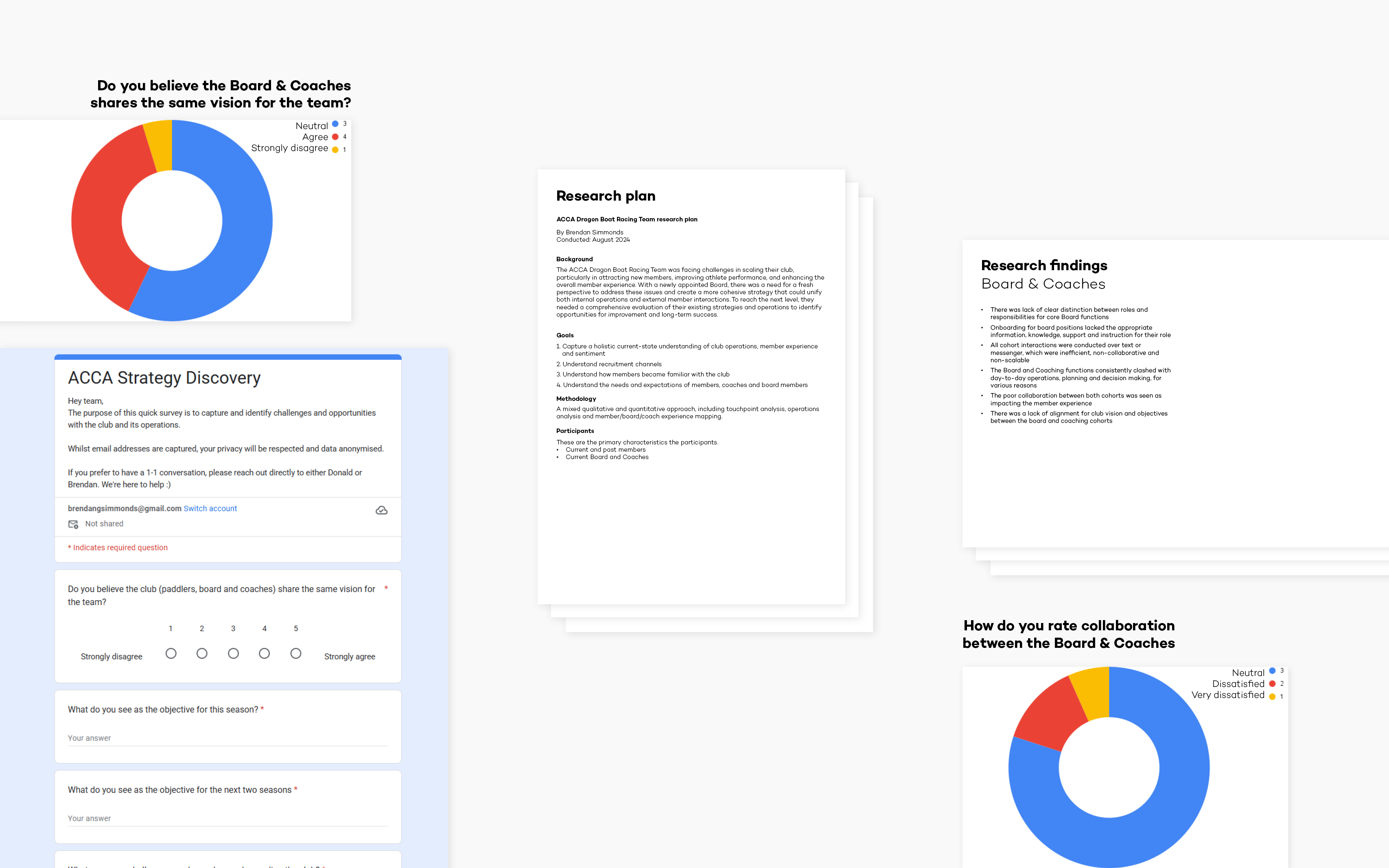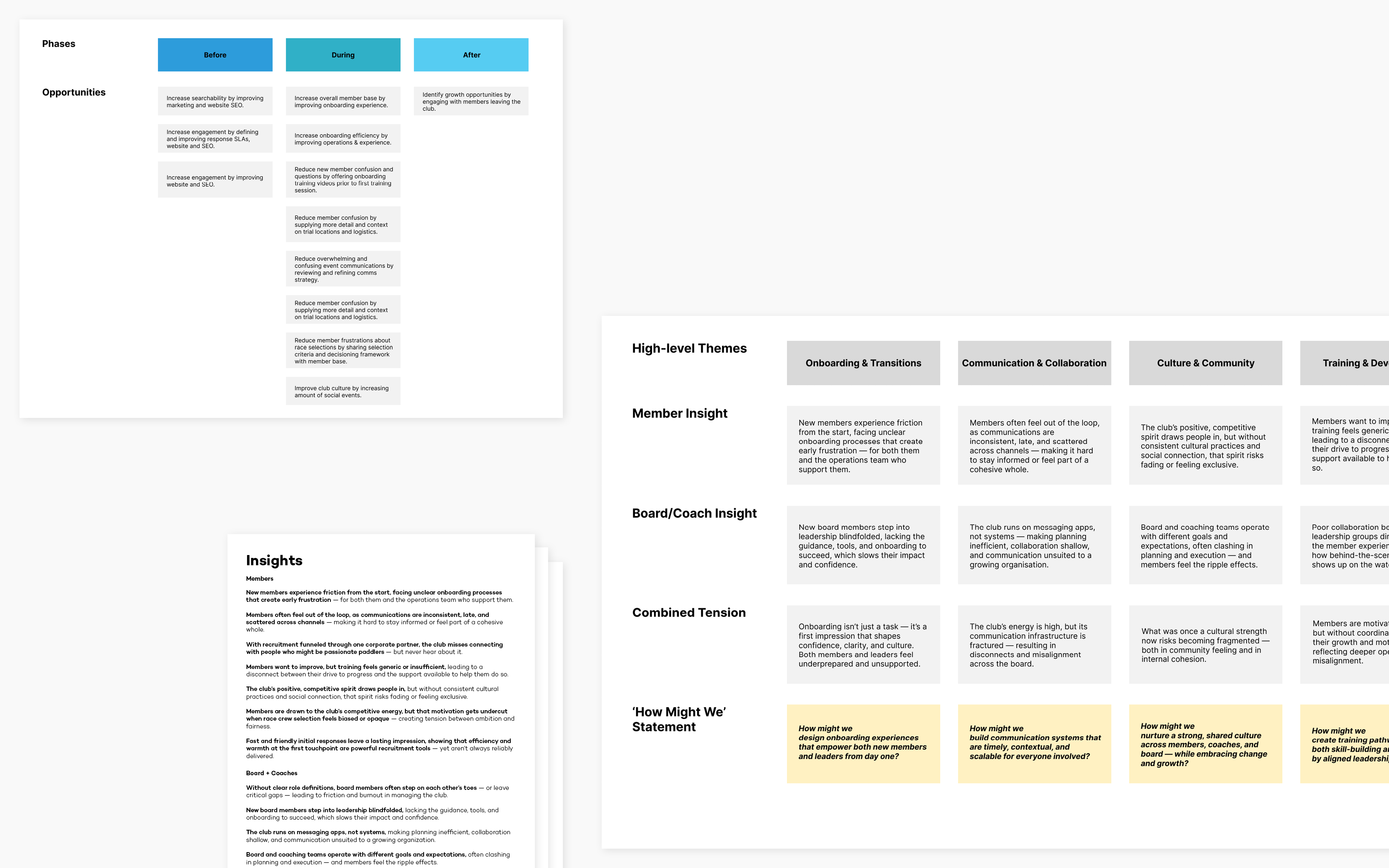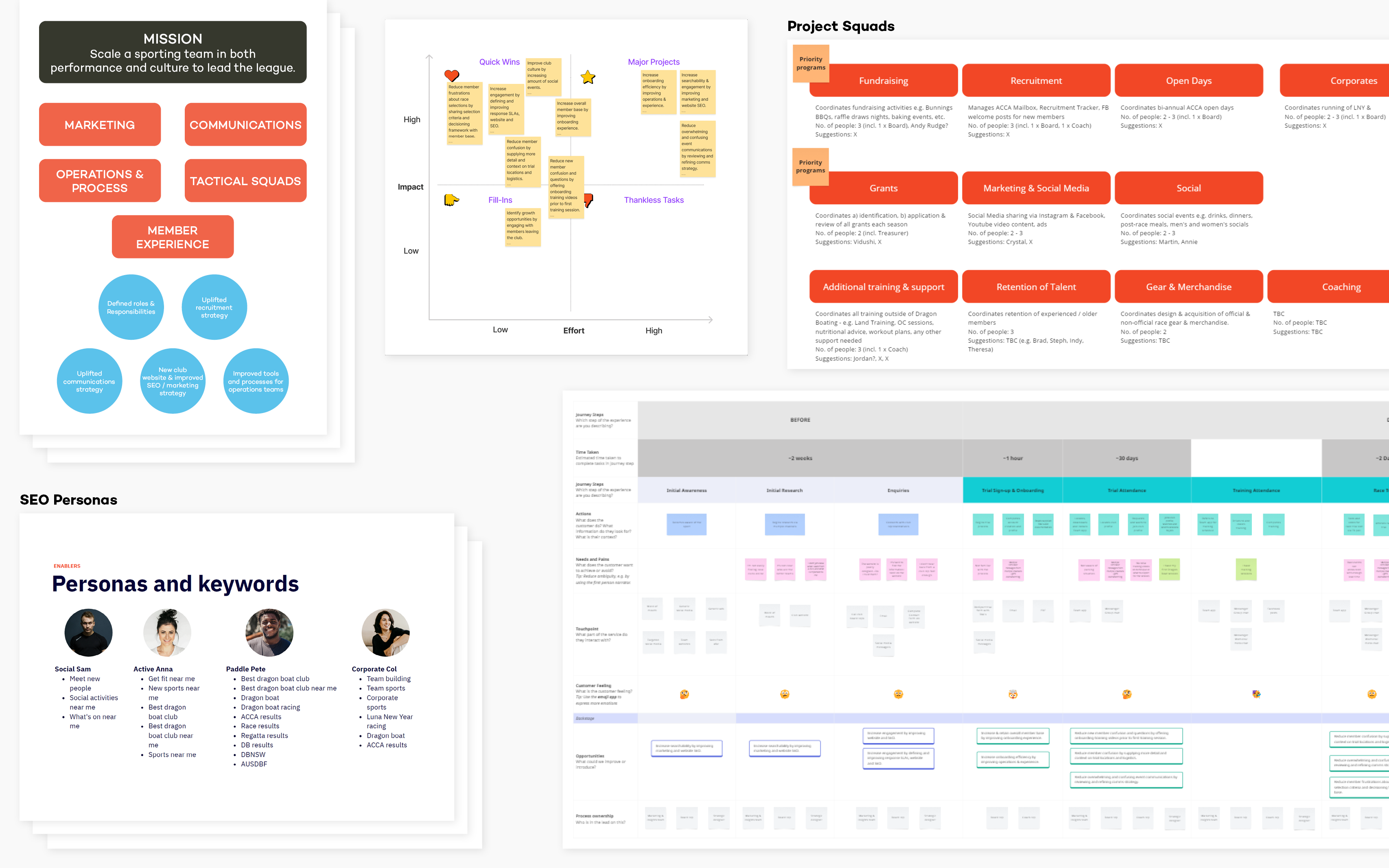CLIENT
ACCA Dragon Boat Racing Club
MY ROLE
Strategic, Service & Product Designer
SUMMARY
The ACCA Dragon Boat Racing Team was ready to grow — but scaling a volunteer-run club comes with its own set of challenges. From member retention to athlete performance and internal operations, the club needed clarity, cohesion, and a shared direction.
Using a Human-Centred Design approach, I identified key friction points across onboarding, communication, and leadership. This led to strategic improvements in marketing, website experience, internal processes, and governance — all tailored to enable sustainable growth while preserving the club’s community spirit.
THE PROBLEM
The ACCA Dragon Boat Racing Team faced challenges in scaling the club, particularly with attracting new members, improving athlete performance, and enhancing the overall member experience.
With a newly appointed Board, there was a need for a fresh perspective to address these issues and create a more cohesive strategy that could unify both internal operations and external member interactions. To reach the next level, they needed a comprehensive evaluation of their existing strategies and operations to identify opportunities for improvement and long-term success.
PROJECT GOALS
Capture a holistic current-state understanding of club operations, member experience and sentiment.
Identify and deliver strategic solutions to address the problem space.
Explore ways to improve the overall operations, member recruitment, retention and experience.
THE APPROACH
A human-centred design methodology was used to gain insight into the current-state experience from the lens of members, Board & Coaching functions whilst leveraging data across various touchpoints.
THE PROCESS

The Process of Design Squiggle by Damien Newman, thedesignsquiggle.com
Assumptions
Discover
Define
Develop
Deliver
Assumption mapping
Initial problem statement
Research plan
Desktop research
Discussion guide
Member & operations facing surveys and analysis
Service safari
Touchpoint & data analysis
Operations analysis
Competitor analysis
Affinity mapping
Themes & insight development
Lean persona development
Revised problem statement
Current-state customer journey map
Current-state service blueprint
Ideation workshops
Prioritisation frameworks
User & task flows
Initial sketches
Lofi wireframes
Digital & service prototypes
Usability testing
User feedback
Iterations
Visual design and brand guide
Refreshed SEO & Marketing strategy
Design & launch of new website
Revamped communications strategy
Enhanced Board operations, tools & processes
Enhanced recruitment, onboarding & retention strategy
Improved coaching engagement strategies
Uplifted recruitment strategy
ASSUMPTIONS
INITIAL PROBLEM STATEMENT
How might we grow the dragon boat club member base, improve athlete performance, and uplift the efficiency of club operations to achieve better outcomes for everyone involved?
Current operations are inefficient and will not scale with club growth.
Communications and operations between club functions are inconsistent and increasingly problematic.
Club members are not satisfied with their experience.
Club website is not performing well as a marketing tool.

DISCOVERY
Members
THE APPROACH
To unpack their overall experience, club members were initially surveyed to understand their experience with the club, their expectations, needs and motivations when joining a competitive team.
Additionally, a number of audits were conducted to understand the member experience, and how it compared to the market and club's competitors.
FINDINGS
Current club communications were seen as late, lacking right level of context, and inconsistently delivered via multiple channels, seemingly without a plan.
Metrics and systems used to inform race crew selections were seen as biased and inconsistently implemented.
The main channel for club recruitment was via their corporate partner, highlighting the need to consider alternative recruitment avenues.
The club culture was seen as fun and competitive, which was the main driver of admissions, with fast enquiry response times increasing recruitment.
Member onboarding was inefficient and riddled with friction for both members and ops teams.
Current targeted training and improvement sessions were seen as insufficient by members.
Historically, club culture was a key asset, but was seen as inconsistent as time progressed, with a desire for more social events.
The club website was not performing well as a marketing tool and ranked poorly when compared to competitors.
DISCOVERY
Board & Coaches
THE APPROACH
To unpack their overall experience, the Board and Coaching functions were initially surveyed to understand their role experience, expectations, needs and motivations when running operations functions.
Additionally, a number of audits were conducted to understand Board and Coach experiences and their operations.
FINDINGS
There was a lack of clear distinction between roles and responsibilities for core Board functions.
There was a lack of alignment for club vision and objectives between the Board and Coaching cohorts.
The Board and Coaching functions consistently clashed with day-to-day operations, planning and decision making for various reasons.
All cohort interactions were conducted over text or messaging apps, which were inefficient, non-collaborative and non-scalable.
Onboarding for Board positions lacked the appropriate information, knowledge, support and instruction for their role.
The poor collaboration between both cohorts was seen as impacting the member experience.

DEFINE
REFINED PROBLEM STATEMENT
How might we create a more cohesive club experience by strengthening onboarding, internal communications, and leadership alignment — in a way that supports both community culture and competitive performance?
THE LEARNINGS
After synthesising insights across members, coaches, and board stakeholders, it became clear that ACCA was facing growing pains typical of volunteer-run, high-performance community organisations.
While the club had a strong spirit and track record, its operational foundation hadn’t evolved with its growth — leading to avoidable friction across onboarding, communication, leadership alignment, and training.
Instead of a single pain point, the real challenge lay in how these issues compounded — affecting confidence, cohesion, and clarity across the club.
KEY INSIGHTS
Onboarding & Transitions
First impressions matter. Friction at the start — whether for new members or board leaders — created confusion and set the tone for the rest of the experience.
Communication & Collaboration
With no central system, the club relied on scattered messaging apps. This created silos and inefficiency, especially as teams scaled.
Training & Development
Members were eager but unsupported. Leadership tensions and unclear progression pathways limited motivation and retention.
Vision & Alignment
Without shared goals and clearer roles, even high-energy environments felt directionless — eroding trust over time.
Culture & Community
The club’s strong, competitive spirit was a powerful attractor — but without shared rituals, expectations, or cultural practices, that strength risked becoming fragmented. Members increasingly described feeling “on the outside” of an unspoken inner circle, pointing to a lack of inclusive behaviours and consistent leadership modelling. What once united the club was now at risk of creating divisions.

DEVELOP
THE APPROACH
Insights gathered during research were used to frame opportunity areas and inform a co-design workshop series with members, coaches, and board members. We explored various ideas across key themes — onboarding, communication, leadership alignment, and training.
A prioritisation framework (impact, effort, feasibility, viability) was used to refine concepts and align them with club capacity and goals. Early ideas were tested through informal member interviews, rapid feedback, and collaborative sessions.
EXPLORED AREAS
Member onboarding flows and transitional moments (e.g. from new joiner to active paddler).
Consistent communication tools and tone across SMS, email, and socials.
Clarity and fairness in race crew selection and training progression.
Culture initiatives to improve belonging and visibility of contribution.
Board and coach role clarity for smoother operations.
DELIVER
WHAT WAS DELIVERED
The final delivery included a mix of quick, tactical wins alongside larger, more strategic plays — all designed to address critical pain points across the club’s operations, communications, and culture. Whether rolling out new communications templates or rebuilding the club’s digital presence, each initiative was seen as a necessary enabler — laying the groundwork for sustainable growth, smoother collaboration, and a stronger member experience.
Member journey map developed to visualise current-state experience and identify key improvement areas.
Co-designed omni-channel communication plan, including consistent templates across key touchpoints.
Improved operational infrastructure, including project management tools and a central knowledge hub.
Clear role definitions for Board and Coaching functions to support smoother collaboration.
Transparent crew selection criteria and ongoing communication to build fairness and trust.
New website with refreshed branding, improved content strategy, and SEO uplift.
Introduction of Squads — self-directed working groups focused on priority areas such as fundraising, recruitment, retention, social events, and marketing.

KEY LEARNINGS
Design for people, not just processes
While it was tempting to optimise systems and tools first, what truly unlocked change was understanding the human moments behind them — confusion during onboarding, frustration around selection, or isolation in leadership roles. Designing for clarity, confidence, and connection made a bigger impact than simply streamlining steps.
© 2025 Brendan Simmonds. All rights reserved.

